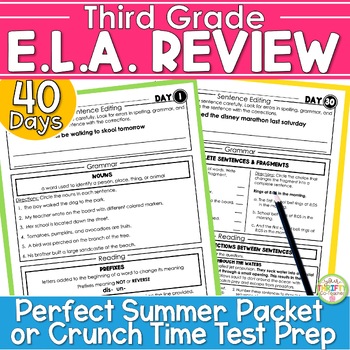3rd Grade ELA Test Prep Review | End of Year Summer Review Packet Worksheets
Your Thrifty Co-Teacher
8k Followers
Grade Levels
3rd - 4th
Subjects
Resource Type
Standards
CCSSRL.3.1
CCSSRL.3.2
CCSSRL.3.3
CCSSRL.3.4
CCSSRL.3.5
Formats Included
- PDF
Pages
85 pages
Your Thrifty Co-Teacher
8k Followers
What educators are saying
This has been a great way for my students to review all they have learned. It's a wonderful morning work activity for when they first come into class.
Also included in
- Whether you’re in test prep mode or getting ready to send out that summer review packet, this 3rd & 4th grade ELA worksheets bundle provides an stress-free review for your students. The pages are designed to be quick and concise to help them retain concepts they learned throughout the school yeaPrice $9.25Original Price $13.50Save $4.25
Description
Whether you’re in test prep mode or getting ready to send out that summer packet, these third grade ELA worksheets provide a stress-free review for your students. The pages are designed to be quick and concise to help them retain concepts they learned throughout the school year.
This set includes grade level skill activities that 3rd graders are expected to have mastered. It is great for helping during state testing prep and perfect to help avoid the summer slide as a homework packet providing bite-sized review of concepts.
Make sure to check out the Preview for a Sample.
A 4th Grade Edition and 5th Grade Edition are also now available.
Includes:
- a total of 40 printable student pages with answer key pages
- cover pages (summer review packet, test prep review, and back to school review)
- student Track Your Progress page
- table of contents
- teacher notes page with suggestions on how to use
- parent letter explaining how they can use student tracker page to encourage their child
Grammar skills covered:
- Nouns
- Capitalizing Proper Nouns: people’s names, holidays, product names, geographical names
- Plural Nouns
- Collective Nouns
- Pronouns
- Reflexive Pronouns
- Possessive Nouns
- Concrete vs. Abstract Nouns
- Verbs
- Simple Verb Tenses: present, future, past
- Subject-Verb Agreement
- Pronoun Antecedent Agreement
- Adjectives
- Adverbs
- Comparative and Superlative Adjectives
- Simple Sentences
- Complete Sentences vs. Fragments
- Coordinating Conjunction
- Compound Sentences
- Subordinating Conjunctions & Complex Sentences
- Punctuating Addresses
- Punctuating Dialogue
- Commas in a Series
- Punctuating Greetings & Closings of Letters
- Capitals: in Titles
- Contractions
Reading Skills Covered:
- Prefixes
- Suffixes
- Roots
- Distinguish Literal and Nonliteral Meaning of Words
- Context Clues
- Text Features
- Ask & Answer Questions about Key Details
- Main Idea & Key Details
- Cause and Effect
- Sequencing
- Compare and Contrast
- Compare and Contrast Two Texts
- Connecting Words and Pictures in Informational Text
- Describing Connections Between Sentences
- Describing Connections Between Paragraphs
- Author’s Point of View
- Ask and Answer Questions about Stories
- Describe Characters: Character Traits (Supported by Text Evidence)
- Recount a Story (Summarize)
- Determine a Central Message: Theme
- Parts of a Story: chapters and how they build off each other
- Parts of a Play: scenes and how they build off each other
- Parts of a Poem: stanzas and how they build off each other
- Point of View
©Your Thrifty Co-Teacher
Total Pages
85 pages
Answer Key
Included
Teaching Duration
2 months
Report this resource to TPT
Reported resources will be reviewed by our team. Report this resource to let us know if this resource violates TPT’s content guidelines.
Standards
to see state-specific standards (only available in the US).
CCSSRL.3.1
Ask and answer questions to demonstrate understanding of a text, referring explicitly to the text as the basis for the answers.
CCSSRL.3.2
Recount stories, including fables, folktales, and myths from diverse cultures; determine the central message, lesson, or moral and explain how it is conveyed through key details in the text.
CCSSRL.3.3
Describe characters in a story (e.g., their traits, motivations, or feelings) and explain how their actions contribute to the sequence of events.
CCSSRL.3.4
Determine the meaning of words and phrases as they are used in a text, distinguishing literal from nonliteral language.
CCSSRL.3.5
Refer to parts of stories, dramas, and poems when writing or speaking about a text, using terms such as chapter, scene, and stanza; describe how each successive part builds on earlier sections.






